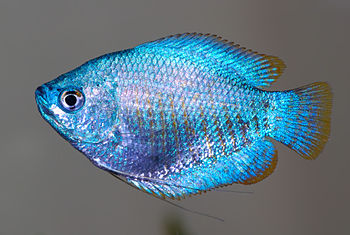Cichlids are not the only species to create a spawning site or to practise parental control over their young. Members of the Labyrinthfish group, such as Gouramies and Siamese Fighting Fish - also have a refined method of reproduction.
 |
| Dwarf Gourami female (Colisa lalia). (Photo credit: Wikipedia) |
It is preferable to give these fish a separate tank in which to spawn; this is not just out of courtesy but perhaps to preserve the tranquility of the community aquarium. In this example, the Dwarf Gourami, Colisa lalia, might be thought a peaceful species but during the build up to spawning the male turns quite ferocious. In a tank containing mostly livebearers, one ardent Dwarf Gourami managed to kill off the majority of the other species before anyone realized what was happening.
There is no difficulty in sexing these fish. The male's flanks are adorned with bright red diagonal stripes and as the onset of spawning occurs his throat and chest region take on a turquoise hue. In contrast, the female can be said to be a little dowdy, just a silvery blue-grey color with only a hint of lines on her side. Of course, following a period of conditioning she will fill out as the eggs build up in her body.
The procedure of the spawning ritual is this: the male constructs a floating bubble-nest using saliva and also fragments of plant material. Usually this is placed in a quiet area of the tank, away from any flow of water returning from the filtration system. The nest extends 2-3 cm (1") into the air and has a diameter of around 10 cm (4"). At the end of this construction phase, the male then entices the female to inspect the structure and, if approval appears forthcoming then the next part of the spawning occurs. However, should the male decide that the female is not quite acceptable to him or she disdains his invitation and shows little interest in his labours then it is likely that he will attack her.
It is therefore important that the spawning tank is well-planted so that the female can escape from the male until she can be rescued (by removal from the tank by the fishkeeper). Of course, plant material is also welcomed by the male to provide building materials for the bubble-nest.
It is possible to condition a pair of Dwarf Gouramies in the spawning tank by using a piece of glass or sheet plastic to divide the tank into two sections. Simply place each fish in their respective halves of the tank and feed well for a couple of weeks.
At the end of the conditioning period, remove the partition and watch what happens, being prepared all the time to step in if the female is attacked. It may be that if a sheet of glass had been used as a partition, the male fish will have had continuous sightings of the female during the conditioning period and may well have begun, or even completed, building a bubble-nest in anticipation of their reunion.
Assuming that all goes to plan, the two fish will embrace beneath the nest, the female will roll over on to her back and the released eggs will be fertilized by the male and float up into the bubble-nest. At the end of the spawning action, the female will probably make a dash into the nearest plants, at which time she should be removed as she will take no further part in the spawning procedure.
Left to his own devices, the male sets about patrolling beneath the nest, regularly repairing parts of it that may be disintegrating and restoring any of the fry that fall out.
One problem with the Dwarf Gourami is the size of the fry or, to be more specific, their need for tiny food. Here the fishkeeper must fall back on to liquid fry food at least, or try a piece of hard-boiled egg yolk squeezed in a piece of cloth in some aquarium water. Do not add too much for fear of tank water pollution. Another possibility is to use 'green water'. This is something that is anathema to pond owners but it can contain microscopic life forms that the fry can eat. Unfortunately, this must obviously be produced ahead of the spawning in order to be ready when needed, so it takes a little forethought to prepare a jar of water and stand it in bright sunshine for a couple for weeks, although you could time it to coincide with the parents' conditioning period.
Eventually the fry will reach a size where they can move on to the usual fry-feeding programme.
There is often quite a high mortality rate of the fry. Some say this occurs around the second week and often point it to cold air entering the aquarium when the hood is opened. To this end, many drape a towel over the hood to exclude draughts but this must be done with caution if the hood is not to over-heat from the lights inside.
Dedi Walker is a writer and fish enthusiast. She shares additional information in sites such as Fish Tank and Tilapia Fish [ Article Source: EzineArticles |

No comments:
Post a Comment